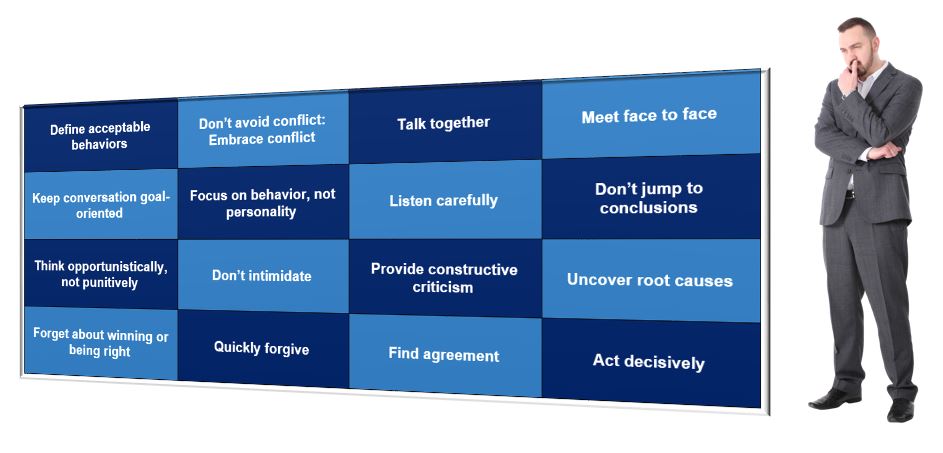Introduction
COVID-19 will bring about many genuine situations of workplace empathy and community. Still, sadly the crisis will inevitably result in flashpoints of personal anger and interpersonal conflict. The pandemic is a painful catalyst that provokes a range of personal emotions, including anxiety and fear about the future and a deep feeling of loss. People may feel anger about job loss, changes in responsibilities and routines, absence of normality, financial uncertainty, self, and loved ones’ health, and socializing with family and friends in a pre-COVID-19 manner. While anger is a mostly normal human reaction, too much anger can unsettle your life and those around you.
For many, anger may be the domineering response, mainly if rage is the typical reaction from uncomfortable and harmful encounters. People more vulnerable to anger from previous incidents may instinctively react with anger arousal with pandemic-inspired threats. Being moored in an earlier unpleasant trouble underlies rage and feeds an overly intense and unproportionate conflict.
Outlined in the table below are the essential terms associated with workplace conflict discussions.
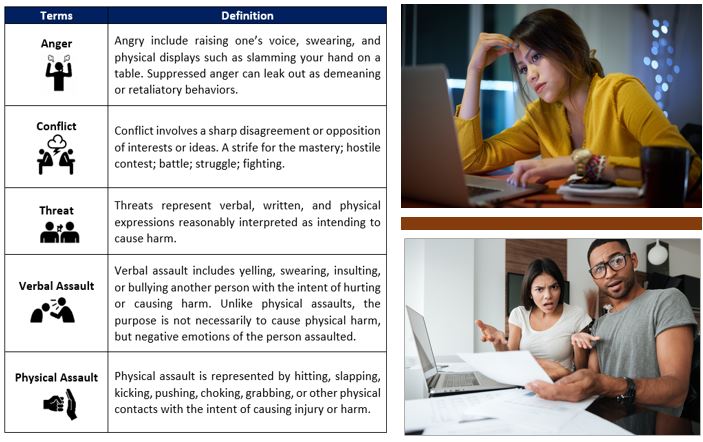
Maintaining good relationships among employees and teams is essential to avoid misunderstandings, silences, and unconsidered messaging that can easily result in workplace conflict. Destructive responses tend to escalate and prolong conflict because the anger targets’ emotions can quickly become aroused and cause retaliatory reactions. This condition can begin a retaliatory spiral where peoples’ negative emotions feed off each other.
It is crucial to good governance to prevent or quickly defend against and diffuse anger situations. In these trying times, to avoid or halt all forms of aggression, executives and managers need to develop policies, procedures, and tools for employees to be mindful of workplace conflict triggers and appropriate coping mechanisms. The practical technique for use will vary according to an organization’s culture and personality, acceptable behaviors, and requirements and incentives to be a good corporate citizen.
“For many, the word conflict is inextricably associated with anxiety and stress and so they spend time trying to avoid it. However, it is impossible to avoid conflict because conflict always arises in situations where people have goals, ideas, and plans that are incompatible with another.”
Kettering University
Anger: The Human Experience
Anger is an emotion that can range from mild irritation to intense rage. As a critical human emotional state, anger involves an inner emotional response and an outer behavioral response and consists of three forms of anger: emotional, cognitive, and behavioral. Irrespective of the source, there is nothing wrong with feeling angry. Anger becomes a concern when people cannot express or deal with anger’s feelings appropriately.
Anger classically theorized as an adaptive response and a version of the fight or flight response believed to have evolutionary usefulness in protecting us from danger. These encounters coincide so that an individual usually experiences them within a surge of anger, as outlined below.
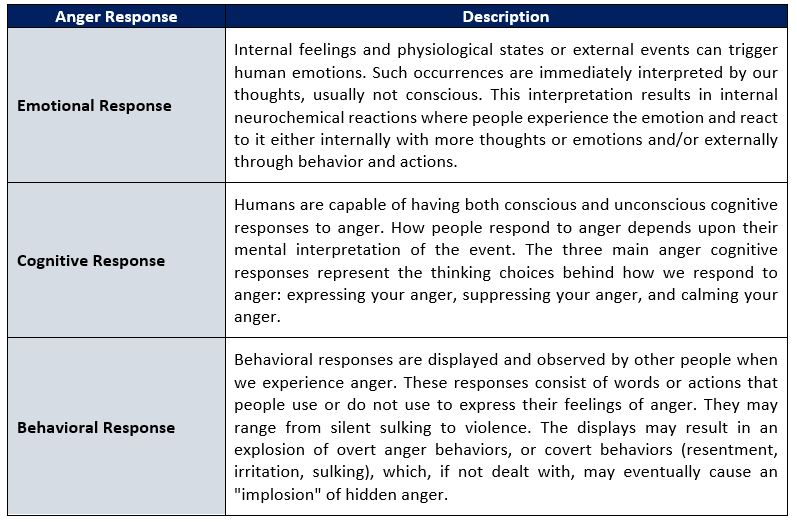
Outlined below are the different types of anger displayed in social settings and the work environment.
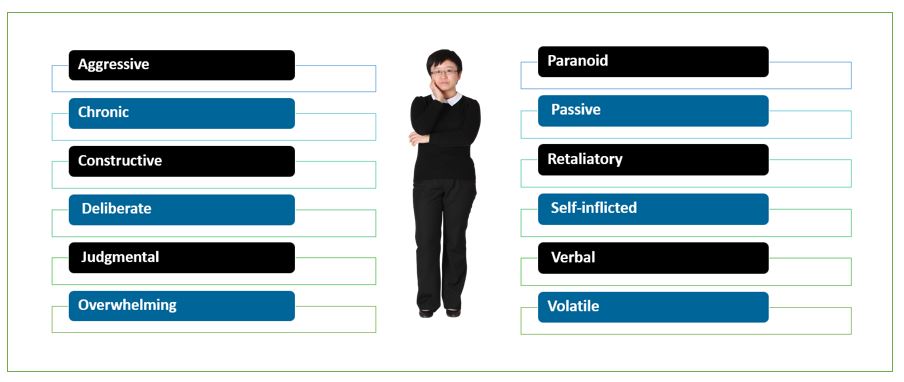
All experiences of anger usually display a condition of helplessness and have the following elements in common.
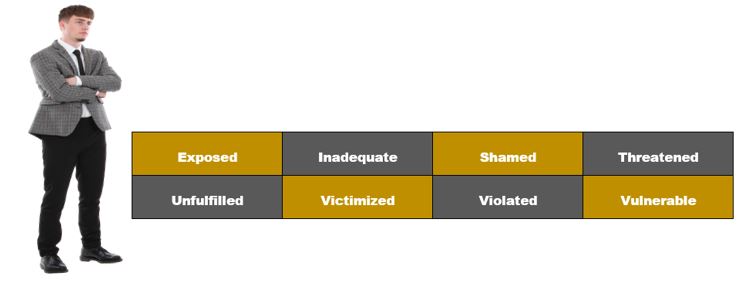
Anger provides energy and motivation for challenging activities and work tasks. Anger, not unlike pain, may serve as an indication that something is amiss with our attempts to relate to our environment. Anger may benefit our relationships when we can work out the root causes positively in anger situations. Anger can also be an early warning sign that something is wrong with our interactions with others.
There is no disagreement that uncontrolled anger can adversely affect physical health and emotional wellbeing. Anger and aggressive behavior increase people’s probability of developing or worsening coronary heart disease conditions. Anger can also increase people’s insomnia and digestive disorders and may lead to violent and destructive behaviors.
Workplace Conflict Essentials
Quickly identifying and resolving workplace conflicts is a continual challenge for commercial and public sector executives. Pre-COVID-19, workplace conflict was inevitable and an anticipated condition with the constant introduction of new technologies, processing complexities, governmental regulations, and different employee generational behaviors. Wherever two or more people come together, there is the potential for unavoidable stressful situations that predictably lead to conflict! On balance, two people are not likely to agree on everything, all the time.
As human beings, we are so unique from each other with different needs and behaviors that it is impressive we do not have more disagreements. Each person has a different set of values and beliefs that influences her or his views and actions. Each individual also possesses different sets of goals, wants, and needs. In the workplace, each employee may have other notions and insights on resolving problems and making decisions. Too often, people believe that there has to be a winner in a conflict. In these situations, they do not try to find a consensus and harmony with their colleagues.
Conflict is a condition that makes people feel threatened because another person or persons confront their thoughts, judgments, or perspectives. At the center of all conflict-inspired threat is fear. Commonly, fear sets in motion two individual responses:
- Aggressively try to resolve the dispute or,
- Avoid the conflict, hoping that it will resolve itself or go away.
Workplace conflict is a state of discord caused by the actual or perceived opposition of needs, values, and interests between people working together. Conflict significantly impacts organizational dynamics and collective results. As business units and teams are required to work closely with each other, these environments, by nature, tend to produce misunderstandings and disagreements. Every organization is distinctive, with varying thresholds for conflict and resolution approaches.
There are various conflict enablers in work settings, including the highly-recognized situations presented below.
Background Individualisms: conflicts can arise between people because of differences in age and generational groups, educational backgrounds, ethnic heritage, gender, and religious and political preferences.
Divergent Values: the typical workplace comprised of workers view the business differently and oppose traditional policies. Conflict occurs when there is a lack of acceptance and understanding of these differences.
Personal Ambitions: conflict occurs when employees struggle to achieve their career ambitions, overlooking organizational goals and cultural well-being.
Personality Clashes: With the workplaces made up of differing personalities, disagreements and misunderstandings will usually occur. Unless colleagues understand and accept each other’s roles, responsibilities, problem-solving style, and decision-making approach, conflicts will occur.
Poor Performance: when one or more individuals are not performing to plan and not addressed, conflict is inevitable.
Weak Communication: lack of timely and effectual workplace communication drives conflict underground and ensues misunderstandings and a continual need for revisiting and clarification.
Insufficient Resources: too often, employees feel they have to compete for available resources to do their job. In a scarce resource workplace, conflicts arise despite awareness of how limited resources may be.
“Conflict itself is not necessarily negative. From different points of view, breakthrough ideas or strategies can be found. Synergies can be developed. Wounds can be healed.”
Society for Human Resource Management (SHRM)
No one appears to be immune to cope with circumstances where factions, differences of beliefs, or attitudes, or worse, transpire into damaging workplace conflicts. Not all problematic conflicts are resolvable. Sometimes, the best decision is to agree to disagree. When people can respect one another’s perspective without anger, wanting revenge, or reprisal, the conflict is resolved positively.
The below statements commonly amplify the definition of “Conflict.”
- Conflict arises from differences, both large and small. It occurs whenever people disagree over their values, motivations, perceptions, ideas, or desires. Sometimes these differences appear trivial, but when a conflict triggers strong feelings, a deep personal need is often at the core of the problem.
- Conflict is more than just a disagreement. It is a situation in which one or more individuals perceive a threat, whether real or feigned.
- Conflicts, when ignored, continue to fester. Since unresolved conflicts involve perceived risks to people’s well-being and survival, they stay open until settled.
- People respond to conflict conditions based on their sensitivities of the situation and belief system, and not necessarily to an objective review of associated facts.
As workplace disagreements materialize into serious clashes, there is a likelihood of lowered employee morale, increased absenteeism and malingering, attrition, decreased productivity, lower quality outputs and deliverables, and possibly litigation.
Recent research reveals that a failure to manage conflict successfully can costs many organizations one full day of productivity monthly or two and a half weeks annually. Generally, as a rule of thumb, managers spend about 25% of their day resolving conflicts among their employees that invariably reduces the time devoted to mission-critical activities.
A conflict of business ideas may be valuable if the employees involved are open to resolving by joint brainstorming. Sometimes, the collaborative outcome can be better than either of the original practices and enable positive changes that would otherwise never have happened.
“The majority of employees (85%) have to deal with conflict to some degree and 29% do so “always” or “frequently.”
CPP Global Human Capital Report
Effectively managing workplace conflict is a priority that management must proactively address with governance and coaching to avoid where required and quickly resolve conflict situations. Internal policies, processes, and procedures should be capable of rapidly recognizing and mitigating conflict conditions. Being defensive is essential in preventing individual disputes that may destabilize employee cooperation, productivity, and impact customer fulfillment and satisfaction.
“Half of all employees (49%) see personality clashes and warring egos as the primary cause of workplace conflict. Stress is second, selected by a third (34%) of workers as the prime cause of disagreements, while a similar percentage (33%) identify workload pressures as a key factor.”
CPP Global Human Capital Report
Anger as a Conflict Trigger
Anger is a human emotion like happiness, sadness, fear, disgust, and surprise. Anger is a sense that is recognized as usual and healthy and serves to let us know when all is not right in our world. Two conditions generally cause anger:
- Frustration: Not getting what we want, especially if we are expecting to receive it.
- Feeling that others do not respect us or care how we think or feel.
When we feel anger as a slight frustration or annoyance, it is simple to handle our response. When anger builds in intensity, depending on our prior experience and ability, it can become progressively hard to manage.
Anger is a significant obstacle to overcome when resolving conflict situations. It is crucial to acknowledge and understand the underlying anger conditions and triggers. These elements will significantly help determine the extent to which conflict escalates or de-escalates and forms a sustainable ‘win-win’ resolution. It is challenging to resolve the dispute if one or more of the parties are still angry!
The Cycle of Anger is comprised of five phases, as shown in the below graphic.
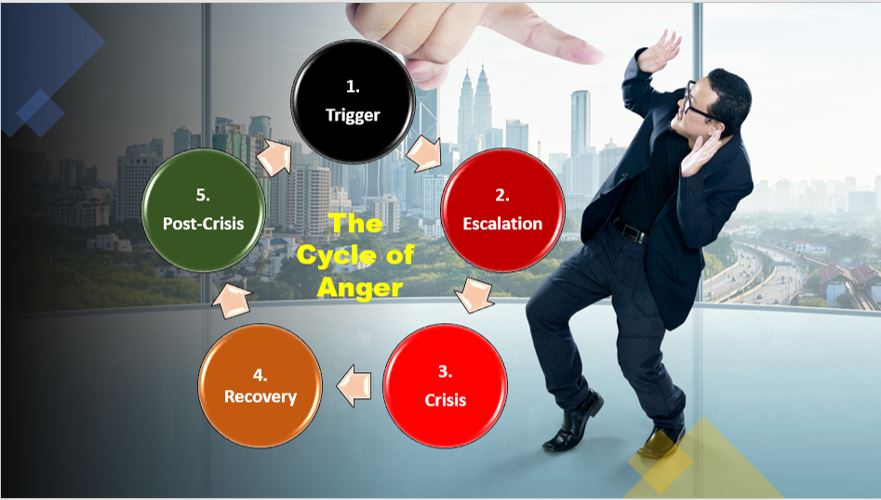
The descriptions of the five Cycle of Anger phases follow in the below table.

“Anger is an acid that can do more harm to the vessel in which it is stored than to anything on which it is poured.”
Mark Twain
Workplace Conflict Sources & Consequences
All workers have needs and expectations at work, and conflict can arise when people feel they are not being met or ignored. It is vital to identify quickly whether a workplace conflict stemmed from an employee personality clash or a dispute over events and decisions associated with specific business culture, policies, and procedures. However, this action may be challenging if the conflict has intensified over an extended time.
The fundamental sources and consequences of workplace conflict highlight the broad scope of disagreements.
Organizational Influenced Conflict
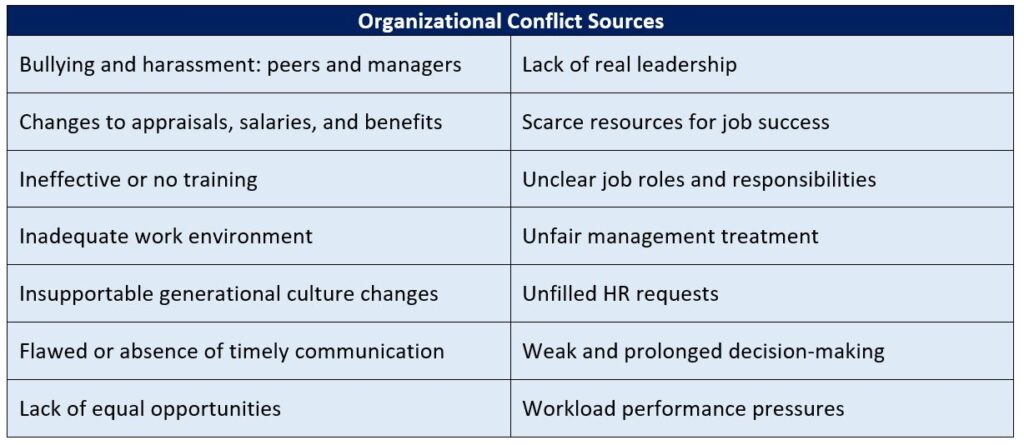
Employee-Rooted Conflict
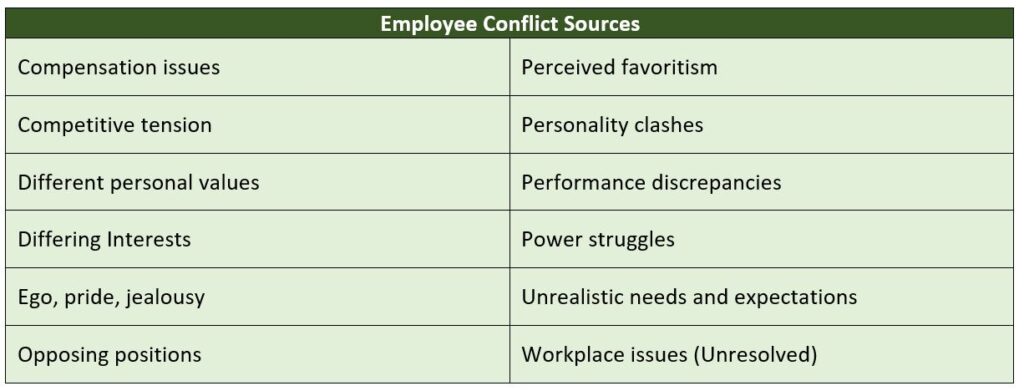
Conflicts attributable to employee-rooted clashes more often than not continue unless people’s attitudes and behaviors change positively. Employee proactive suggestions include:
- Acknowledge that people are unique with different personalities, views, and demeanors.
- Be judicious, courteous, and respectful to colleagues.
- Cease gossip and complaining about other employees to others.
- Understand that disagreements waste precious personal energy, reduce workplace productivity, and result in ‘loss-loss’ workplace situations for all.
Unresolved Workplace Conflict: Consequences
Unresolved workplace conflict situations lead to negative impacts, including the following:
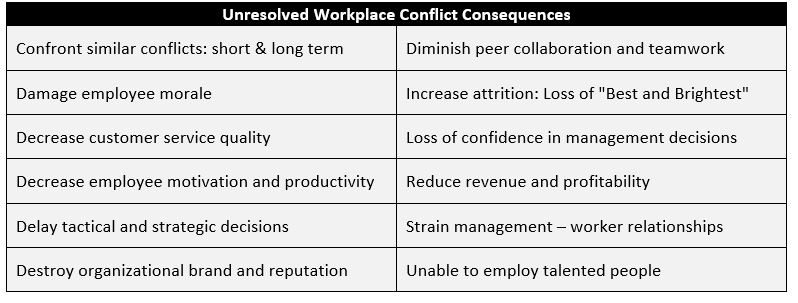
“Remember not only to say the right thing in the right place, but far more difficult still, to leave unsaid the wrong thing at the tempting moment.”
Benjamin Franklin
Conflict Resolution Approaches
The Thomas-Kilmann Conflict Mode Instrument, as presented below, was designed by two psychologists, Kenneth Thomas, and Ralph Kilmann, to explain the options in handling conflict.
Conflict situations are those in which the concerns of two or more individuals appear to be incompatible. In such circumstances, generally, people exhibit two standard Behavior Dimensions shown as axes on the Instrument:
- Assertiveness (vertical axis): the extent to which the individual attempts to satisfy her/his concerns.
- Cooperativeness (horizontal axis): the extent to which the person attempts to support the other person’s interests.
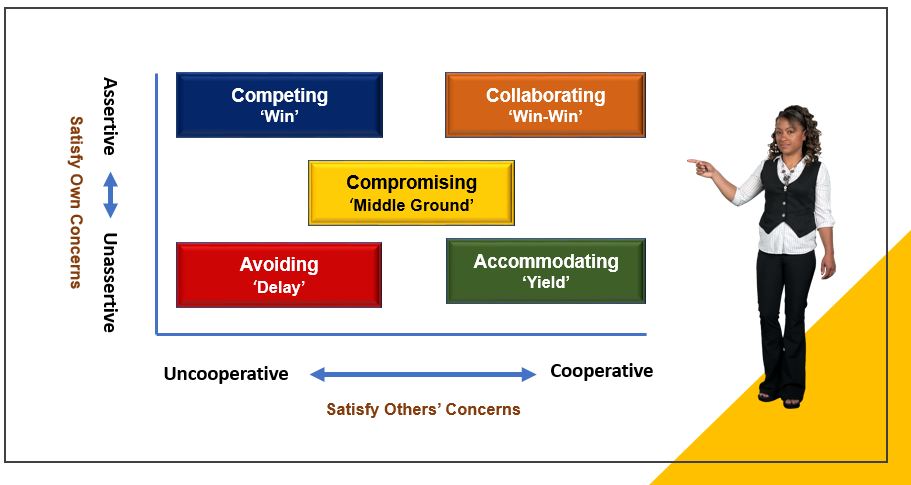
The two Behavior Dimensions provide five Conflict Resolution Methods, as outlined below.
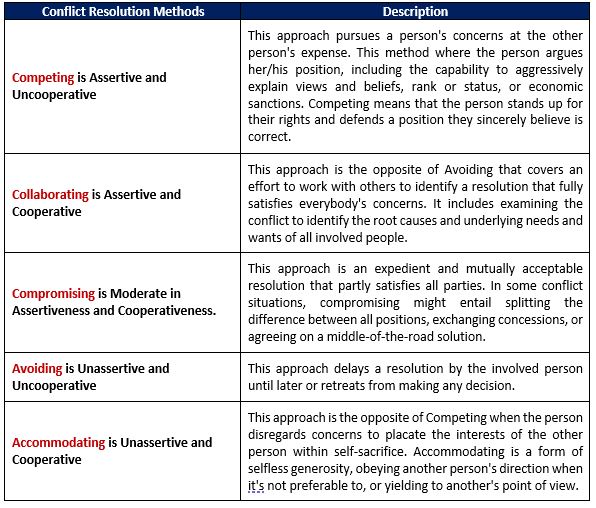
“Listen first. Give your opponents a chance to talk. Let them finish. Do not resist, defend or debate. This only raises barriers. Try to build bridges of understanding.”
Dale Carnegie
Conflict Resolution & Soft Skills
Since conflict will always be present in the workplace, it is vital to develop the skills to control a difficult conversation or interaction appropriately. Conflict competence is the ability to develop and use cognitive, emotional, and behavioral skills that increase positive outcomes while reducing escalation or harm. Conflict management skills are a range of interpersonal and communication soft skills needed for reaching an agreement between two or more parties that already have a disagreement or dispute.
The use of appropriate soft skills required for successful conflict resolution allows for:
- Increase self-awareness for future conflict.
- Enable a collaborative approach to resolving conflict.
- Promote a productive workplace that encourages deferential relationships.
The below graphic highlights the soft skills that support conflict resolution.
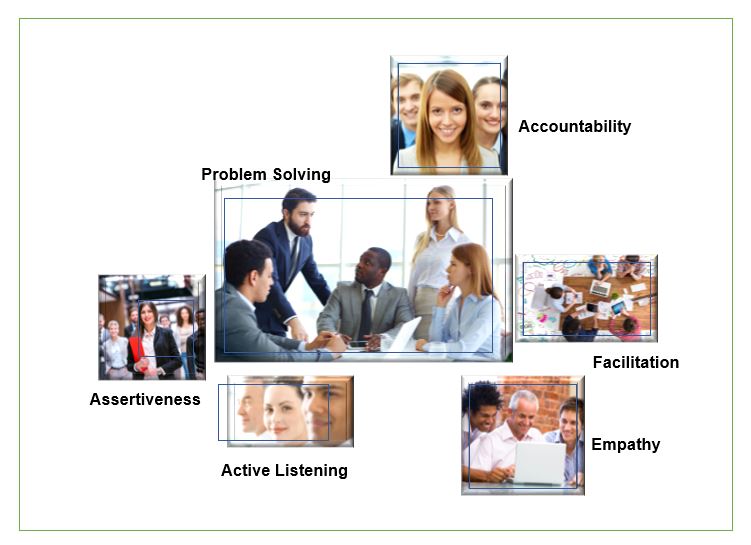
Conflict Resolution Principles
There is a high probability of conflicts when people with different personalities and behaviors work together. When you encounter difficult situations, it is advantageous to remove personal emotions and think strategically about resolving the conflict within a structured approach. Successful organizations recognize the strategic importance of quickly identifying and resolving the conflict by setting-up formalized programs to support employees who cannot diffuse unhealthy workplace situations.
The principles recognized as the most important to successful conflict resolution encompass the below:
Conflict resolution comes down to crucial non-threatening interactions. Managing conflict, at its core, is about being willing to have critical conversations. Most people struggle with identifying and initiating these essential conversations.
By customizing and applying the Conflict Resolution Principles to their cultural and organizational environment, managers will establish a positive conflict-free workplace in which creativity and innovation are encouraged and rewarded.
“Seven out of ten employees (70%) see managing conflict as a “very” or “critically” important leadership skill, while 54% of employees think managers could handle disputes better by addressing underlying tensions before things go wrong.”
CPP Global Human Capital Report
The Way Forward
At Knowledge Compass, we bring together nearly four decades of thought leadership in business and technology strategy, the latest tools and best practices, and a seasoned consultant team with the competencies and talent to help our clients improve productivity and profitability.
Knowledge Compass explores and develops valuable new insights from business, technology, and science by embracing the powerful technology of ideas and brainstorming. Our consultants engage customers in challenging discussion and experimentation to expand business science boundaries and practice and translate creative ideas into practical solutions from within and beyond business.
Working with Knowledge Compass means a collaborative approach to understanding your current business model, strategies, and critical business requirements and goals.
We enable organizations to transform and deliver improved value by ensuring employees adapt and make the most effective use of conflict management and change practices in culture, strategy, infrastructure, and processing. Our consultants have a deep understanding of the social and business factors that support a KM culture aligned with the corporate strategy and goals.
Knowledge Compass provides consulting services using time-tested best practice frameworks, analyses tools, and interactions from their professional Consultant Toolbox.
